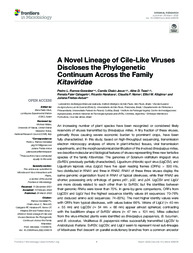A Novel Lineage of Cile-Like Viruses Discloses the Phylogenetic Continuum Across the Family Kitaviridae.
A Novel Lineage of Cile-Like Viruses Discloses the Phylogenetic Continuum Across the Family Kitaviridae.
Author(s): RAMOS-GONZÁLEZ, P. L.; CHABI-JESUS, C.; TASSI, A. D.; CALEGARIO, R. F.; HARAKAVA, R.; NOME, C F.; KITAJIMA, E. W.; ASTUA, J. de F.
Summary: An increasing number of plant species have been recognized or considered likely reservoirs of viruses transmitted by Brevipalpus mites. A tiny fraction of these viruses, primarily those causing severe economic burden to prominent crops, have been fully characterized. In this study, based on high-throughput sequencing, transmission electron microscopy analyses of virions in plant-infected tissues, viral transmission experiments, and the morphoanatomical identification of the involved Brevipalpus mites, we describe molecular and biological features of viruses representing three new tentative species of the family Kitaviridae. The genomes of Solanum violifolium ringspot virus (SvRSV, previously partially characterized), Ligustrum chlorotic spot virus (LigCSV), and Ligustrum leprosis virus (LigLV) have five open reading frames (ORFs) > 500 nts, two distributed in RNA1 and three in RNA2. RNA1 of these three viruses display the same genomic organization found in RNA1 of typical cileviruses, while their RNA2 are shorter, possessing only orthologs of genes p61, p32, and p24. LigCSV and LigLV are more closely related to each other than to SvRSV, but the identities between their genomic RNAs were lower than 70%. In gene-by-gene comparisons, ORFs from LigCSV and LigLV had the highest sequence identity values (nt sequences: 70?76% and deduced amino acid sequences: 74?83%). The next higher identity values were with ORFs from typical cileviruses, with values below 66%. Virions of LigLV (? 40 nm × 55 nm) and LigCSV (? 54 nm × 66 nm) appear almost spherical, contrasting with the bacilliform shape of SvRSV virions (? 47 nm × 101 nm). Mites collected from the virus-infected plants were identified as Brevipalpus papayensis, B. tucuman, and B. obovatus. Viruliferous B. papayensis mites successfully transmitted LigCSV to Arabidopsis thaliana. SvRSV, LigCSV, and LigLV seem to represent novel sub-lineages of kitaviruses that descent on parallel evolutionary branches from a common ancestor shared with the tentative cile-like virus hibiscus yellow blotch virus and typical cileviruses. Biological and molecular data, notably, the phylogenetic reconstruction based on the RdRp proteins in which strong support for monophyly of the family Kitaviridae is observed, mark an advance in the understanding of kitavirids.
Publication year: 2022
Types of publication: Journal article
Unit: Embrapa Cassava & Fruits
Keywords: Brevipalpus, Ornamental plants, Planta Ornamental, Virion, Vírus
Observation
Some of Embrapa's publications are published as ePub files. To read them, use or download one of the following free software options to your computer or mobile device. Android: Google Play Books; IOS: iBooks; Windows and Linux: Calibre.
Access other publications
Access the Agricultural Research Database (BDPA) to consult Embrapa's full library collection and records.
Visit Embrapa Bookstore to purchase books and other publications sold by Embrapa.

